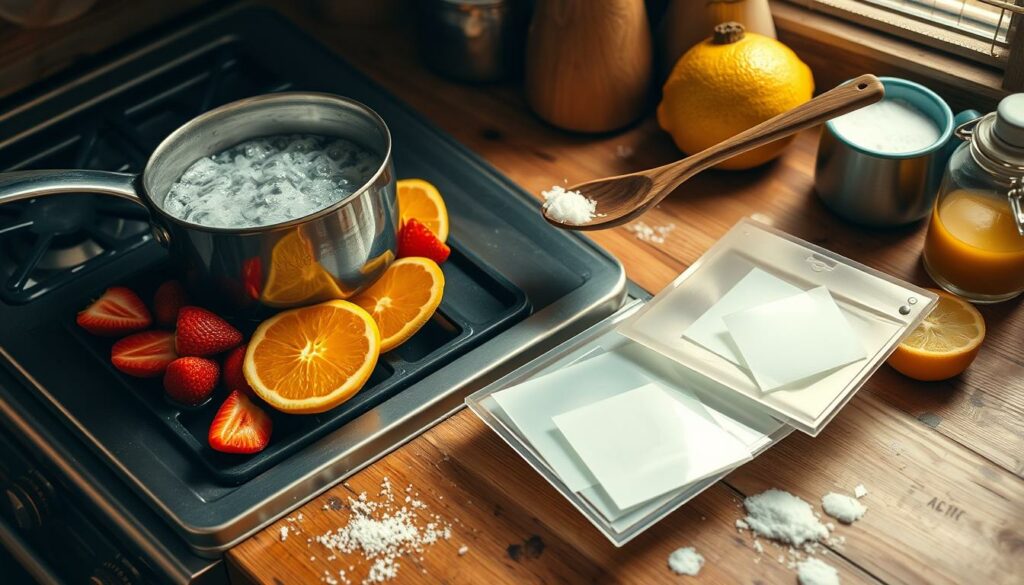Ever thought about making that wiggly, versatile ingredient in your kitchen? Making gelatin from scratch might seem hard, but it’s a fun DIY project. It can make your cooking better. This guide will show you how to make your own gelatin at home, revealing its secrets.
By making gelatin yourself, you can choose the best ingredients. You can make gummy bears, desserts, or add texture to soups. Homemade gelatin is pure and can be tailored to your liking. Let’s explore how to turn simple animal products into a cooking gem.
Making gelatin at home saves money and lets you know what’s in your food. This guide will teach you to extract collagen and turn it into gel. You’ll be able to wow your loved ones with your homemade gelatin dishes!
Table of Contents
Key Takeaways
- Homemade gelatin offers control over ingredient quality and source
- The process involves extracting collagen from animal tissues
- DIY gelatin is cost-effective and customizable
- Homemade gelatin can be used in desserts, soups, and more
- Making gelatin from scratch is a rewarding culinary skill
Understanding Gelatin Basics and Its Properties
Gelatin is a key ingredient in many dishes. It’s important to know about its basics and special traits. This knowledge will help you make great homemade gelatin.
What is Gelatin?
Gelatin comes from animal collagen. It’s made from bones, skin, and connective tissues. Its unique properties make it essential in cooking and food making.
Chemical Structure and Properties
Gelatin is made of long amino acid chains. These chains help gelatin form gels and add texture to food. Knowing these properties is crucial for making homemade gelatin.
Natural Sources of Gelatin
Gelatin mainly comes from animals. Common sources are:
- Bovine bones and hides
- Porcine skin
- Fish scales and bones
Each source has different gelatin properties. This affects how it’s used in recipes. For plant-based options, note that ancient pizza recipes were vegan. They showed how non-animal ingredients can mimic gelatin’s texture.
| Source | Gel Strength | Melting Point |
|---|---|---|
| Bovine | High | 95-100°F |
| Porcine | Medium | 75-80°F |
| Fish | Low | 65-70°F |
Understanding these basics prepares you for making homemade gelatin. The type of gelatin you use can change your dish’s taste and texture.
Essential Ingredients and Equipment Needed
To make gelatin at home, you need certain ingredients and tools. First, you’ll need animal bones or skin. These are key for making gelatin. You also need water and vinegar or lemon juice to extract the gelatin.
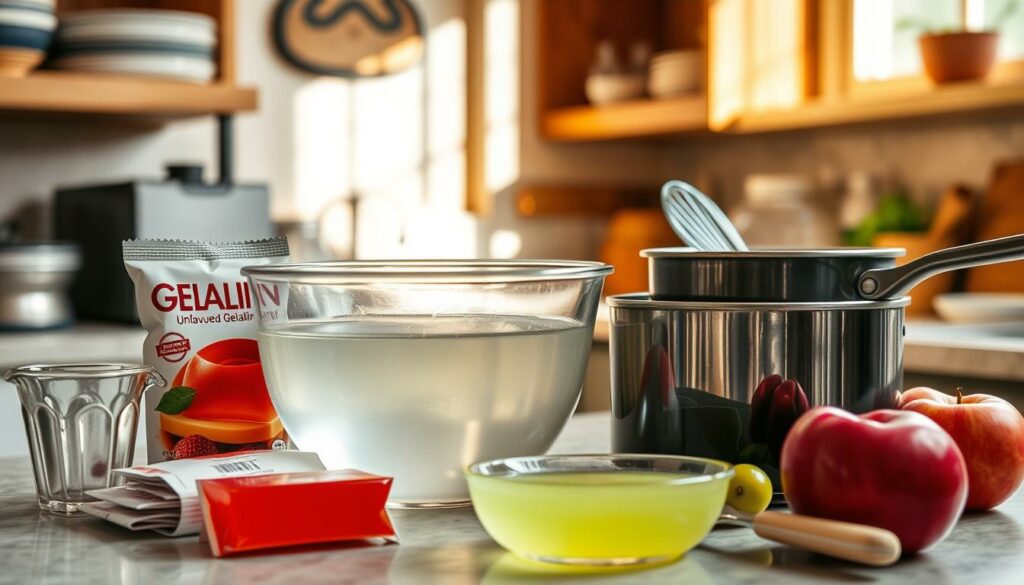
You’ll need a big pot to simmer the mix. A strainer and cheesecloth help separate the liquid gelatin from solids. Don’t forget storage containers to keep your gelatin fresh. A thermometer is useful for keeping the right temperature.
Here’s a list of key items you’ll need:
- Animal bones or skin
- Water
- Vinegar or lemon juice
- Large pot
- Strainer
- Cheesecloth
- Storage containers
- Thermometer
With these ingredients and tools, you’re set to begin your gelatin-making journey. Using the right stuff is key for making great homemade gelatin.
| Ingredient | Purpose | Equipment | Function |
|---|---|---|---|
| Animal bones/skin | Source of collagen | Large pot | Simmering mixture |
| Water | Extraction medium | Strainer | Separating liquid |
| Vinegar | Collagen breakdown | Cheesecloth | Fine filtering |
How to Make Gelatin at Home?
Making gelatin at home is a fun and rewarding task. It lets you choose the best ingredients. This homemade gelatin recipe has several steps, from getting the raw materials to storing the final product.
Preparing Raw Materials
First, pick high-quality animal tissues full of collagen. Clean and cut these tissues into small pieces. This makes it easier to extract the gelatin.
Extraction Process
The next step is to simmer the tissues in water with an acidic ingredient. This breaks down the collagen into gelatin. Keep the heat low and steady to avoid damaging the proteins.
Straining and Purification
After simmering, strain the mixture through cheesecloth to get rid of solids. Let it cool, then skim off the fat that rises to the top. This makes the gelatin even purer.
Setting and Storage
Put the purified liquid in the fridge to set. Once it’s firm, cut it into blocks. Store these blocks in an airtight container in the fridge for later use.
| Step | Duration | Key Point |
|---|---|---|
| Preparation | 30 minutes | Clean and cut tissues |
| Extraction | 3-4 hours | Simmer at low heat |
| Straining | 15 minutes | Use fine cheesecloth |
| Setting | 4-6 hours | Refrigerate until firm |
Traditional Methods vs Modern Approaches
Gelatin production has changed a lot over time. Old ways involved long simmering and manual work. Now, we use new equipment and science.
Making gelatin at home used to take a lot of time. You’d simmer animal parts for hours, then strain and cool it. It needed patience and careful work.
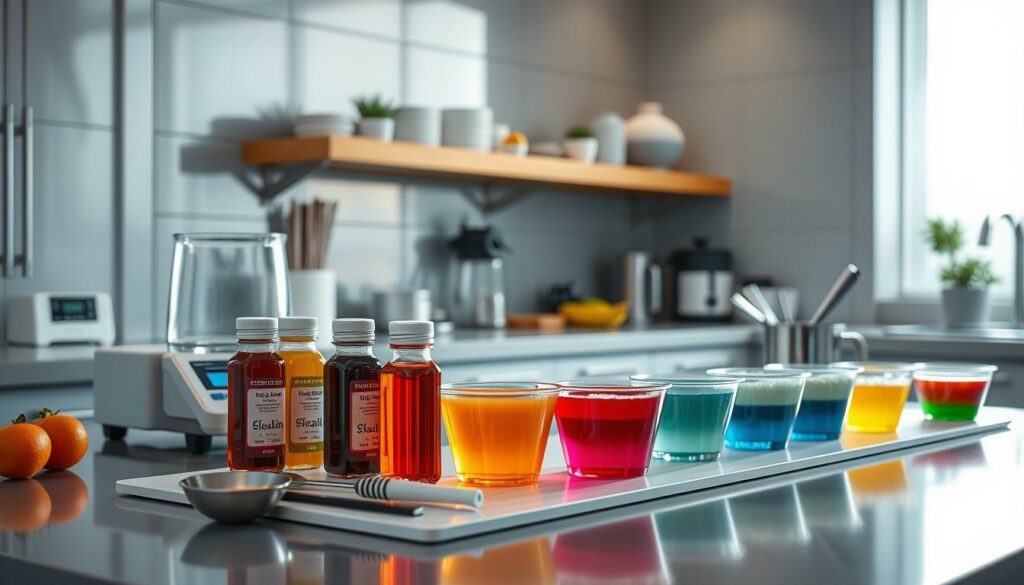
Today, we have quicker ways to make gelatin. Pressure cookers cut down cooking time from hours to minutes. Some methods use enzymes to get better gelatin.
| Aspect | Traditional Method | Modern Approach |
|---|---|---|
| Processing Time | 6-8 hours | 1-2 hours |
| Equipment | Basic kitchen tools | Pressure cookers, specialized extractors |
| Yield | Lower | Higher |
| Quality Control | Variable | Consistent |
Both old and new methods have good points. Traditional ways give a hands-on feel and need simple tools. Modern methods are quicker and often give better results. Your choice depends on what you have, what you want, and your taste in making gelatin.
Safety Precautions and Best Practices
Making gelatin at home needs careful attention to safety and hygiene. By following proper gelatin safety precautions, you can ensure a high-quality product that’s safe to consume. Let’s explore key practices for temperature control, sanitization, and homemade gelatin storage.
Temperature Control
Keeping the right temperature during gelatin extraction is key. Keep your mixture between 140°F and 180°F to prevent bacterial growth. Use a food thermometer to monitor the temperature closely throughout the process.
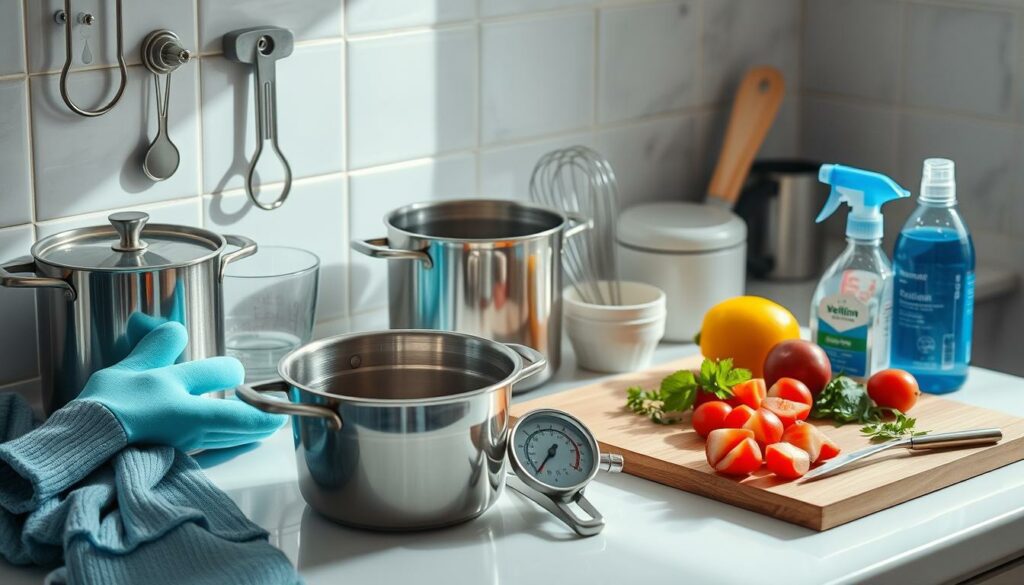
Sanitization Guidelines
Clean all equipment thoroughly before use. Wash utensils, pots, and containers with hot, soapy water. Rinse well and dry with clean towels. Consider using a diluted bleach solution to sanitize surfaces and equipment for extra precaution.
Storage Requirements
Proper homemade gelatin storage is essential for maintaining quality and safety. Store your finished gelatin in airtight containers in the refrigerator. For longer shelf life, you can freeze gelatin for up to six months. Label containers with the date of preparation to track freshness.
| Storage Method | Temperature | Shelf Life |
|---|---|---|
| Refrigeration | 32°F – 40°F | 1-2 weeks |
| Freezing | 0°F or below | Up to 6 months |
By following these safety precautions and storage guidelines, you’ll create a safe and high-quality homemade gelatin product. Remember, food safety is paramount when working with homemade ingredients.
Common Mistakes to Avoid
Making gelatin at home can be rewarding, but knowing common mistakes is key. Understanding these errors can help you make better gelatin. This way, you’ll get better results.
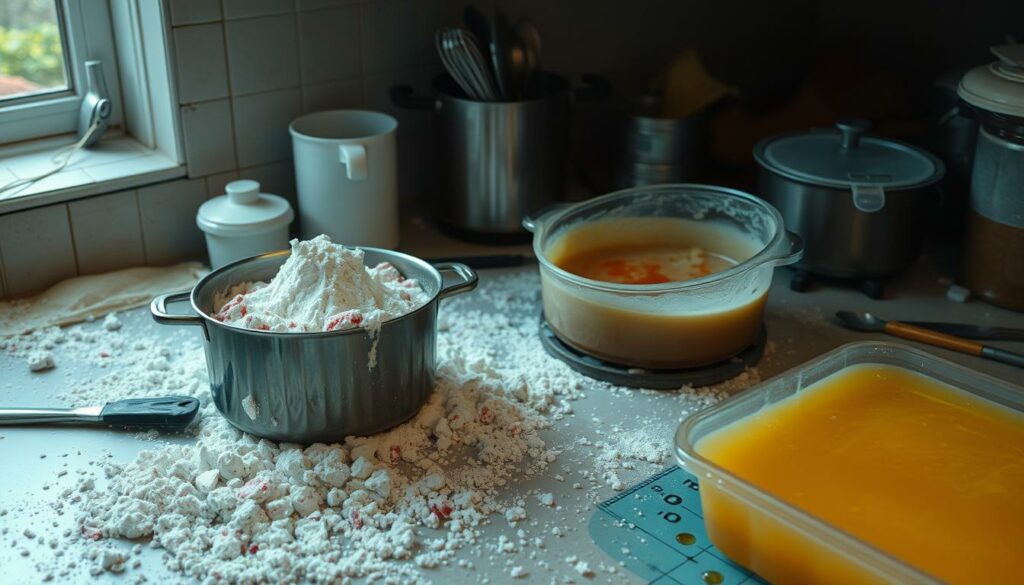
One common mistake is overheating. This can ruin the gel’s strength. To prevent this, use gentle heat and keep an eye on the temperature.
Another mistake is not straining well enough. This can make your gelatin cloudy. Make sure to strain well for a clear gelatin.
The right water ratio is also important. Too much water makes the gel too soft, while too little makes it stiff. Always follow recipes and adjust as needed for the right texture.
| Common Mistake | Effect | Prevention |
|---|---|---|
| Overheating | Denatured proteins, weak gel | Use gentle heat, monitor temperature |
| Poor straining | Cloudy gelatin | Strain thoroughly, multiple times if needed |
| Incorrect water ratio | Too soft or too stiff gelatin | Follow recipes, adjust as needed |
| Contamination | Spoiled gelatin, health risks | Use clean equipment and fresh ingredients |
Contamination is a big risk when making gelatin at home. Always use clean tools and fresh ingredients for safety. By avoiding these mistakes, you’ll make perfect homemade gelatin every time.
Vegetarian and Vegan Alternatives
If you’re searching for vegetarian gelatin alternatives or gelatin-free substitutes, you’re in luck. The food industry has come up with several plant-based options. These mimic gelatin’s properties without using animal products.
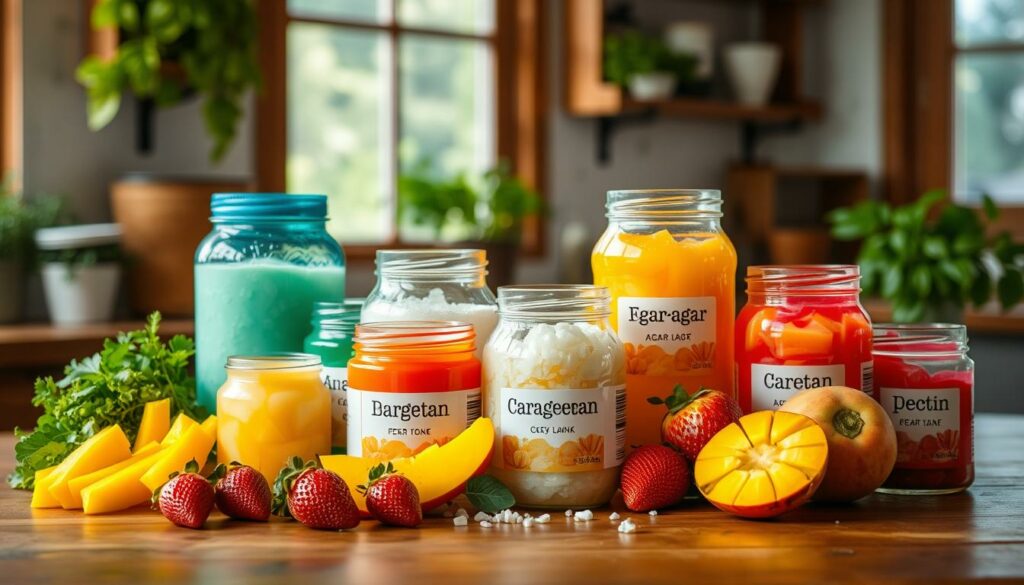
Agar Agar Substitution
Agar agar comes from seaweed and is a top gelatin-free substitute. It sets more firmly than gelatin and stays stable at room temperature. Use it in a 1:1 ratio to replace gelatin in most recipes.
Carrageenan Options
Carrageenan, another seaweed extract, thickens and stabilizes well. It’s commonly found in dairy-free milk alternatives and desserts. However, some people may have sensitivities to carrageenan.
Pectin-Based Alternatives
Pectin, found in fruits, is perfect for jams and jellies. It works best in acidic environments and creates a softer set than agar agar. Use it to make fruit-based desserts and spreads.
| Alternative | Source | Best Use | Set Strength |
|---|---|---|---|
| Agar Agar | Seaweed | Gummy candies, jellies | Firm |
| Carrageenan | Seaweed | Dairy alternatives, puddings | Soft to medium |
| Pectin | Fruit | Jams, fruit spreads | Soft |
These vegetarian gelatin alternatives are versatile in cooking and baking. Try out different options to find the best gelatin-free substitute for your recipes.
Creative Uses for Homemade Gelatin
Homemade gelatin opens up a world of possibilities in the kitchen. You can make delicious homemade gelatin desserts that taste better than store-bought ones. Try making smooth panna cotta or fun fruit jellies. Your creativity in the kitchen has no limits.
Dessert Applications
Gelatin is great in desserts, adding a smooth texture. You can make classic mousse or colorful parfaits. Or, try making gummy candies in fun shapes and flavors. The possibilities are endless with homemade gelatin desserts.
Culinary Uses
Gelatin is not just for desserts. It’s also useful in cooking. It helps clarify stocks and consommés, making them clear. It also stabilizes whipped cream, keeping it fluffy longer. In savory dishes, gelatin improves the texture of terrines and aspics, adding a professional touch.
Medicinal Benefits
Homemade gelatin is not just for eating. It’s full of collagen, which may help with joint health and skin. Some people use it as a natural supplement. While health benefits can vary, many find it helpful for their wellness.
| Application | Usage Rate | Popular Forms |
|---|---|---|
| Desserts | 65% | Jellies, Mousses, Panna Cotta |
| Culinary | 25% | Stock Clarification, Stabilizers |
| Medicinal | 10% | Supplements, Topical Applications |
Exploring these uses can help you get the most out of homemade gelatin. It will improve your cooking skills and overall health.
Troubleshooting Guide
Making gelatin at home can be tricky. You might face some homemade gelatin problems along the way. This guide will help you tackle common issues in gelatin troubleshooting.
Weak gels are a frequent concern. If your gelatin doesn’t set properly, you might not have used enough powder. Try increasing the concentration next time. Remember, temperature matters too. Make sure you’re following the recipe’s setting instructions carefully.
Cloudy gelatin is another issue you might encounter. This often happens when you don’t strain the mixture well enough. Use a fine-mesh strainer or cheesecloth to filter out any impurities. This extra step can make a big difference in the clarity of your final product.
Unpleasant odors can ruin your gelatin. This usually occurs when ingredients aren’t fresh. Always use high-quality, fresh materials. Store your homemade gelatin in an airtight container in the fridge to prevent off-smells from developing.
- For weak gels: Increase gelatin concentration
- For cloudiness: Improve filtration methods
- For bad odors: Use fresh ingredients and store properly
By addressing these common gelatin troubleshooting issues, you’ll be on your way to creating perfect homemade gelatin every time. Don’t get discouraged if you face setbacks. With practice, you’ll master the art of gelatin making.
Nutritional Benefits and Health Considerations
Gelatin is good for your health and has important nutrients. Knowing about gelatin nutrition facts helps you choose better foods. Let’s look at what gelatin offers for your health.
Protein Content
Gelatin is high in protein, coming from animal collagen. It has amino acids that help your body work right. Even though it’s not a full protein, it can help meet your protein needs.
Collagen Benefits
The collagen in gelatin can help your joints, skin, and gut. Many people use gelatin to improve their skin and digestion. These benefits make gelatin popular in food and health products.
Dietary Considerations
Remember these points when adding gelatin to your diet:
- Gelatin is not for vegetarians or vegans
- It might affect some medicines
- Some might be allergic to gelatin
Always talk to a doctor before changing your diet. Knowing about gelatin’s nutrition and benefits helps you decide if it’s right for you.
| Nutrient | Amount per 100g |
|---|---|
| Protein | 85.6g |
| Fat | 0.1g |
| Carbohydrates | 0.1g |
| Calories | 335 |
Storage and Shelf Life Tips
Storing gelatin right is key to keeping it good and lasting longer. Dry gelatin should be in airtight containers in a cool, dry spot. This stops it from getting wet and keeps it working well.
For gelatin you’ve already made, the fridge is your best friend. It can last 1-2 weeks there. If you need to keep it longer, freezing is a good choice. Frozen gelatin can stay good for up to 6 months, keeping its texture and taste.
- Use clean, sterilized containers for storage
- Label containers with preparation date
- Keep gelatin away from strong odors in the fridge
- Thaw frozen gelatin in the refrigerator overnight
Always check for signs of spoilage before using. If it smells bad, looks off, or has mold, throw it away. By following these tips, your homemade gelatin will stay fresh and safe to eat.
“Proper storage is the key to extending the life of your homemade gelatin creations.”
Conclusion
Making gelatin at home is a fun and rewarding task. This guide has shown you how to do it, from the basics to the advanced steps. By making your own gelatin, you save money and get a product without additives.
Homemade gelatin is more than just a kitchen tool. It’s packed with protein and might even help with collagen. You can use it in many ways, from desserts to savory dishes, and even for health benefits.
Start your gelatin-making adventure and try new things. Don’t worry if it doesn’t work out at first. With time, you’ll get better. Follow the safety and storage tips in this guide to keep your gelatin fresh and safe. Now, you’re all set to get creative and enjoy your homemade gelatin.
FAQ
What are the main ingredients needed to make gelatin at home?
To make gelatin at home, you need animal bones or skin, water, and vinegar or lemon juice. These ingredients help extract collagen and make gelatin from scratch.
How long does the gelatin extraction process take?
The gelatin extraction process takes several hours. Traditional methods simmer the tissues for 6-8 hours. Modern methods using pressure cookers can shorten this to 2-3 hours.
Can I use any type of animal bones to make gelatin?
You can use different animal bones, but the best are from pigs, cows, chickens, or fish. Avoid bones from animals treated with hormones or antibiotics.
How do I store homemade gelatin, and how long does it last?
Dry gelatin should be stored in airtight containers in a cool, dry place. Refrigerate or freeze prepared gelatin. It lasts 1-2 weeks in the fridge or up to 6 months in the freezer.
Are there any vegetarian or vegan alternatives to traditional gelatin?
Yes, there are plant-based alternatives. Agar agar from seaweed is a common choice. Carrageenan and pectin, also from seaweed and fruits, work well in many recipes.
What are some common uses for homemade gelatin?
Homemade gelatin is versatile. It’s great in desserts like mousses and panna cotta. It’s also used in gummy candies, clarifying stocks, stabilizing whipped cream, and improving meat textures. Some use it for joint health and skin benefits.
How can I troubleshoot weak gels when making gelatin?
Weak gels often come from too little gelatin or wrong setting conditions. Increase gelatin, cool properly, or adjust pH. Avoid overheating the gelatin to preserve protein quality.
What are the nutritional benefits of homemade gelatin?
Homemade gelatin is high in protein and essential amino acids. It’s rich in collagen, which supports joints, skin, and gut health. However, it’s not a complete protein source.
How do I know if my homemade gelatin has gone bad?
Bad gelatin shows off odors, mold, or texture and color changes. Always check before using. If unsure, discard it.
Can I use gelatin molds with homemade gelatin?
Yes, homemade gelatin works well in molds. It lets you create shapes for desserts. Just make sure it’s set before unmolding.

